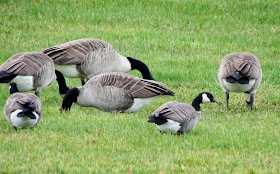Travel is the best way to experience the vast wonders of nature, and I have done my share. The verdant forests of West Virginia, the rocky mountains of Colorado, and the breath-taking vistas from Big Sur California, each are special for their own unique flora and fauna.
Nothing annoys a plant enthusiast more than golf-course grass in the middle of a dessert or palm trees in Nevada! Seriously, we should travel to experience each unique location, not to visit some homogenization of landscape or the floristic counterpart of McDonald's fast food!
 |
This gorgeous model has not been compensated to appear in this picture.
Yes, she is my daughter. |
Experience the beauty of each place. Breath deeply. Let the colors penetrate your soul, and you will soon know why so many people migrate to the blue of Lake Erie for their vacations and relaxation. This particular spot in Lakeside, Ohio is very special to my entire family. One can visit our history and the natural world simultaneously. View Perry's Monument on Put-in-Bay and scan little known
Mouse Island, just off the point of Catawba Island.
No one enjoys horticulture more than I do. After all, gardening is my primary hobby and it was once my livelihood. But, I have evolved. Now I want more than ornamental plants such as hosta and day-lilies. Subtle grasses and delicate flowers have their place too.
 |
| Quite possibly America's rarest flower, the Lakeside Daisy. |
Too often we overlook the beauty in front of our very eyes. The
Lakeside Daisy was considered unremarkable by locals, until visiting botanists recognized it for the rarity we now know it to be.
Consider the delicate flowers desperately clinging for life on an
alvar, battered by waves of water and ice in hostile Lake Erie.
 |
| Little Blue Stem grasses line the shore. |
Shorelines are given to erosion, by the same forces that batter those lakeshore alvars. So we are planting deep-rooted native grasses along the lake front on the west end of Lakeside. Native Ohio plants will do well growing in our climate and may have the fortitude to stand up to the temperament of the lake.
 |
| Butterfly-weed, Asclepias tuberosa is a host plant for Monarchs. |
Milkweeds are also being added to the landscape in order to provide nectar and nursery space for Monarch butterflies. Monarchs pass over these shores twice a year, on their way to and from Canada. Much has been written on the plight of our migration Monarchs, and we hope to give them a little assist.
 |
| Zebra-mussels may crowd our shore line, but make attractive slug control in flower beds. |
Even alien invaders can be put to use. Zebra-mussels are unwanted nuisances in our lake, clogging our water intakes and littering or shores with their sharp shells. But, used as a mulching material, they blend in quite nicely with the existing shoreline and make a natural snail barrier for plants. This is far better than using a poisonous snail bait which can harm pets.
Irish compost? Sure, lake-weed is a natural for the garden!
The lake is determined to increase our compost piles with heaps of eelgrass, Vallisneria americana.
Farmers in Ireland have used seaweed to supplement their poor soils through-out the ages. Landscapes on Martha's Vineyard often utilize this bounty from the sea. Why not? Eelgrass is filed with nutrients, readily adaptable to being used as a mulch and dries to a clean straw-like substance.
 |
| Piles of eelgrass on the shoreline. |
When left to rot along the shoreline, eelgrass becomes rather rancid and fishy smelling. Pulled from the water and spread out to dry on the shore, it is odor-free and beneficial to shoreline stabilization. So we can clean up our lakeshore and put the material to good use at the same time. This is just good old Yankee-engineering and common-sense gardening practices.
 |
| Planting Hibiscus moscheutos, our native marsh or rose mallows. |
So join us where the sky meets the lake and the views of the Lake Erie Islands are unhampered! Lakeside is transforming the shoreline with a tidy little clean up along the lake. Plantings will re-introduce localized native plants and utilize some further afield Ohio natives that will thrive in this location.
We think it is a
very progressive way to take a
step back in time and witness our lakeshore au natural.










%2BWhoo's%2Bgot%2Bme.JPG)

















.JPG)











.JPG)


.JPG)











